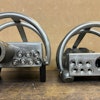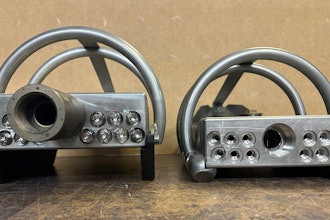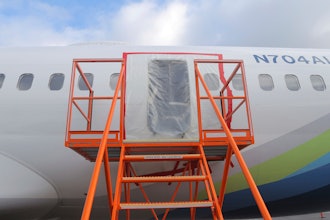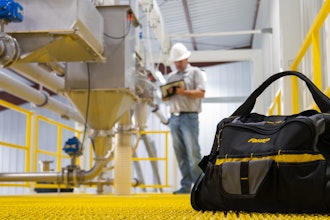For facility managers, selecting the right concrete floor coatings for a manufacturing facility can be a challenge. Depending on the location, the system may need to withstand not only high traffic, but also exposure to potentially damaging chemicals, solvents, extreme pH substances, ongoing moist or wet conditions, thermal shock/ thermal cycling, and a host of other conditions, including requirements imposed by various regulatory agencies.
With dozens of industrial floor coating application styles, thicknesses and coatings to choose from, the first step is a thorough needs assessment, followed by prioritizing those needs to determine the best budgetary allocation. For example, quarter-inch thick, trowel-applied flooring can provide excellent impact resistance and outstanding long-term value. However, whether the optimal flooring material for a given location should consist of an epoxy-aggregate blend or a urethane mortar will depend on various site and operational conditions.
Key Points To Consider
Durability, cleanability and safety are generally at the forefront when it comes to selecting a flooring system. However, resinous flooring can be customized to meet a broader range of criteria, resulting in optimal effectiveness for nearly any facility.
The following is a breakdown of nine key areas to consider as you consult with your resinous floor coating professional:
-
Type and volume of traffic — Does traffic consist of pedestrians, rubber-wheeled vehicles or steel-wheeIed carts? Is traffic ongoing 24/7 or just occasional? Are potentially abrasive items sometimes dragged across the floor? How heavy are the loads being transported?
-
Product(s) being manufactured — If the flooring will be exposed to chemicals, solvents or oils, what are the specific substances and their concentrations? How long do the fluids typically stay on the floor before cleanup? Are silicones or similar materials used during production? Is there potential for abrasive aggregate spillage?
-
Safety — Is a slip-resistant finish required and if so, how mild or aggressive should it be? Are static control properties needed, such as electrostatic dissipative floor coatings to help safeguard sensitive electronics or conductive flooring for rooms storing combustible powders or explosives? Does the facility process food or pharmaceuticals, or house healthcare services, where additional antimicrobial properties may be required of the flooring?
-
Condition of the concrete substrate — If the concrete is new, when was it poured and how was it finished? If older concrete, what is its current condition – is it cracked, pitted, or otherwise damaged? Are there any known concrete moisture or moisture vapor issues? If currently coated, what is the coating type and condition? Are there any known contaminants soaked into the concrete, such as areas with oil, grease, specific chemicals, etc.?
-
General operational environment — Will the floor coating be exposed to very high or very low temperatures or extreme temperature cycling? Is the space considered a clean room or required to be dust-free, solvent-free, etc.? Does any machinery cause excessive movement or vibration of the slab? Is a waterproofing underlayment needed to help protect lower level rooms? Is the entire space indoors, or are some areas open and exposed to the elements?
-
Installation parameters — What will the air and concrete surface temperatures as well as the relative humidity (RH) be during floor coating application? How much time can be allotted for the installation process? Is there adequate access to electrical power and water, as required by installers’ equipment? Will there be other trades working in the area? Will the building be occupied or vacated during installation? Other facility concerns?
-
Cleanability and maintenance — What is the current floor maintenance regime, including specific chemicals and processes used? What is expected of the new flooring in terms of cleaning, maintenance and repair? Is an integral cove base or floor slope correction needed to help the surface drain properly during wash-down?
-
Budget and expected usable life — What is the anticipated usable life of the new floor – 3, 5, 10, 15 or more years? Is the facility a permanent or temporary location? What is the budget allocated for the flooring project?
-
Finish, color and aesthetics — What are facility expectations in terms of color, gloss level, texture and aesthetics? Are safety and aisleway floor markings required? Is there a need to improve room illumination with a reflective, high gloss floor in a lighter color? Is a company logo to be embedded into the floor to help reinforce branding and underscore employee pride-of-place?
Overview of Flooring Types
Each year, innovations in resinous, fluid-applied floor coatings are introduced to the industrial and commercial market. In manufacturing locations, professional factory-approved contractors often install multi-layered flooring systems comprised of several different resin chemistries, providing each facility with customized protection suited to their unique operation.
Some of the options include:
- Epoxy Mortar — Epoxy mortar floors, installed at 3/16-inch – 1/4-inch thick, are made up of industrial-grade epoxy resins and special graded aggregate. Typically applied with a power trowel, these heavy-duty systems can be used to resurface moderate to severely deteriorated substrates and perform impressively over the long term. With its high compressive strength, impact resistance and impressive durability, epoxy mortar flooring is a solid choice for a broad range of manufacturing applications. Various formulations also serve to patch potholes, change the slope of the floor for better drainage or build integral floor-to-wall cove bases. Epoxy mortar floors are suitable for some of the heaviest use environments.
- Epoxy Broadcast — Epoxy broadcast floors, installed in standard thickness of 1/16-inch – 1/8-inch, offer dense, non-porous surfaces that can help restore mildly deteriorated concrete, while imparting additional strength, impact resistance and durability. The application technique involves “broadcasting” aggregate blends onto wet epoxy in multiple layers. Aggregate blends can be comprised of special sand, ceramic-coated colored quartz granules, multi-colored synthetic flakes or natural mineral chips, offering a range of aesthetics, from utilitarian to highly decorative. The final product typically provides moderate slip resistance, which can be augmented to suit facility requirements. Epoxy broadcast floors are ideal for moderate to heavy use environments.
- Cementitious Urethane Slurry or Mortar — Installed at 3/16-inch – 1/4-inch thickness depending on system, cementitious urethanes were originally developed for the extreme conditions found in food and beverage processing plants and commercial kitchens, where they continue to reign supreme. Highly tolerant of moisture, thermal shock and impact, plus a wide range of chemicals and extreme pH substances, cementitious urethane is now seen as an outstanding sanitary flooring solution for a wide spectrum of facility types. It can be used to repair damaged slabs and will accommodate floor slope and the installation of an integral cove base. The systems can be applied to “green” concrete, exhibit low odor during installation, cure quickly, and offer flexible design options, including media broadcast. Cementitious urethane floors provide excellent strength and durability for moderate traffic to very heavy use facilities.
- High Performance Topcoats — A variety of high performance topcoats are available to impart additional properties to nearly any resinous flooring system. Thin film urethanes, polyaspartics and color-stable epoxies are among the products used. Typically ranging in thickness from 3 – 16 mils, the newest generation topcoats provide benefits such as enhanced resistance to chemicals, staining, slippage, abrasion and the like. Professional installers are skilled in selecting the right topcoats for specific flooring systems and environments.
- Special Performance Floor Coating Systems — The flooring needs of manufacturing facilities are many and varied, and resinous flooring can accommodate nearly every need. Beyond static control flooring, antimicrobial systems and compliancy with USDA, FDA or other agency guidelines, some operations require extraordinary concrete protection in the form of secondary containment. Novolac epoxies and vinyl ester coatings can help protect the structural integrity of facilities, as well as the surrounding natural environment, by isolating and allowing proper clean-up of corrosives, caustics, acids, solvents or other hazardous substances.
For the best possible flooring value, both at the time of installation and in terms of ongoing maintenance and repairs over its lifetime, it is important to begin with a thorough needs analysis. Working with an experienced factory-approved contractor can help ensure you install optimal flooring solutions throughout your facility.
Sophia Daukus is Marketing Communications Manager for Florock Polymer Flooring, manufactured in Chicago, IL since 1952. Florock offers one of the most complete lines of epoxy flooring and concrete floor coatings on the market with decorative, high performance solutions to address the unique conditions of nearly every application. From manufacturing to food processing, from education to retail and beyond, Florock provides facilities across a broad spectrum of industries with optimal protection and outstanding flooring value.























